
Iceland is extraordinary. It is volcanic. Landscapes are weird and wonderful, the birds are plentiful, seals and whales frolic round the shores and the rivers are full of fish. The majority of the population of 400,000 or so is descended from Viking or Celt and the Icelandic language is much the same as it was when the Vikings brought it with them from western Norway in the age of settlement in the 9th and 10th centuries AD. Summers can be beautiful and days are long. Winter brings long dark days and snow storms but also the aurora borealis – green furling curtains rolling across the night sky. Culinary delights include horsemeat, sheep’s heads, and fermented shark, while more usual fayre includes lamb, seafood, venison; and blueberries picked from the autumnal hills and plains. And surprisingly they grow many fruits and vegetables, also flowers, under glass using geothermal heat. The same geothermal heat is used for the openair swimming pools in every community throughout the country.
I have lived in Iceland. I have family there and head there most years. I obtained a license as a tour guide a few years ago. June is my favourite month, when the landscape is carpeted with lupins, originally planted to halt soil erosion but seeded everywhere. Moss grown over ancient lava flows is becoming lusher and amorphous patches of grass are alternately bright green (unmown) and straw yellow (mown). Icelandic horses graze in meadows of cotton grass and wild flowers; white, brown and black sheep wander over the hills, and birds are nesting all over the place.
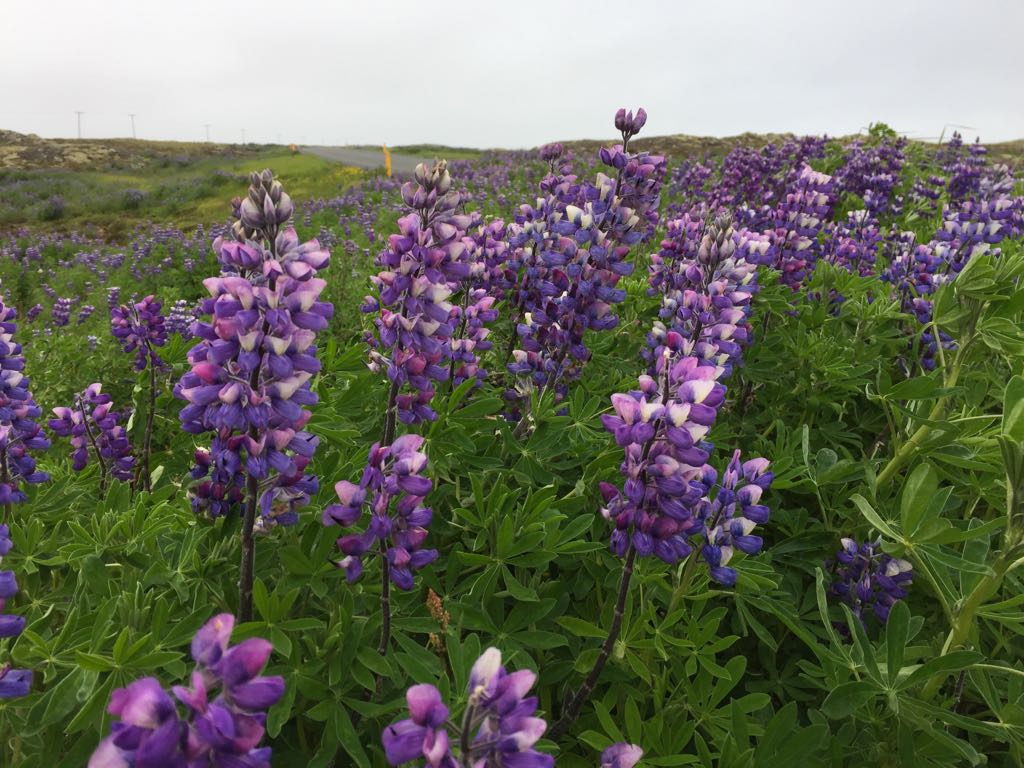
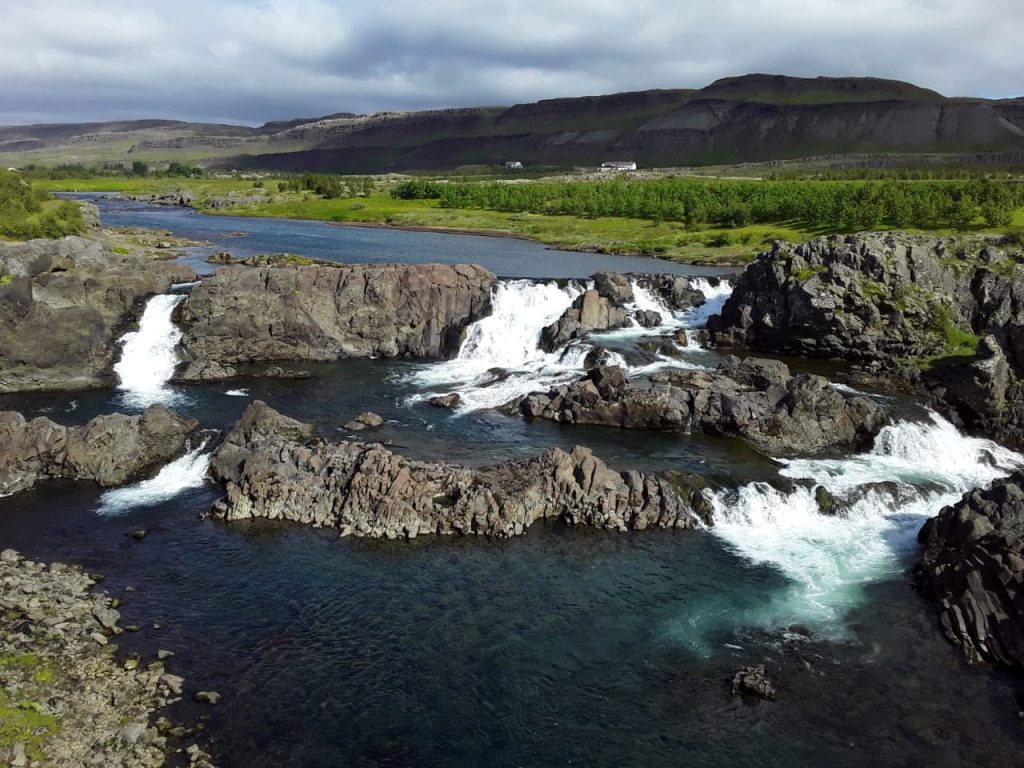
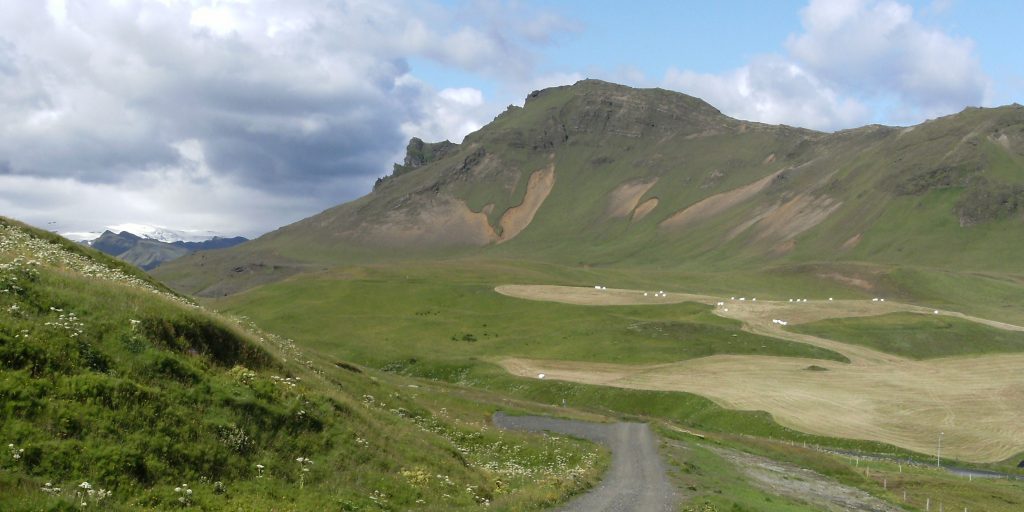
This year, I am visiting my favourite places in south-west Iceland, the area I know best. A relative is lending me his spare red car – oldish but robust. For those without this advantage, there are plenty of day tours, and longer, available from Reykjavík to explore the surrounding countryside. The tour guides are, of course, well informed, welcoming and good company. Otherwise hire a car and explore at your leisure. The best way though, if you have plenty of time, is to bring your own motorhome, or car plus camping gear, via Hirtshals in Denmark and ferry to East Iceland at Seyðisfjörður.
(Note: I have used two old English letters, which are part of the Icelandic alphabet, in place names, as well as some accented vowels: ð is pronounced th as in ‘the’; Þ = th as in ‘thorn’; æ = i as in ‘eye’; ö = er; á = ow as in ‘now’; í = ee.)
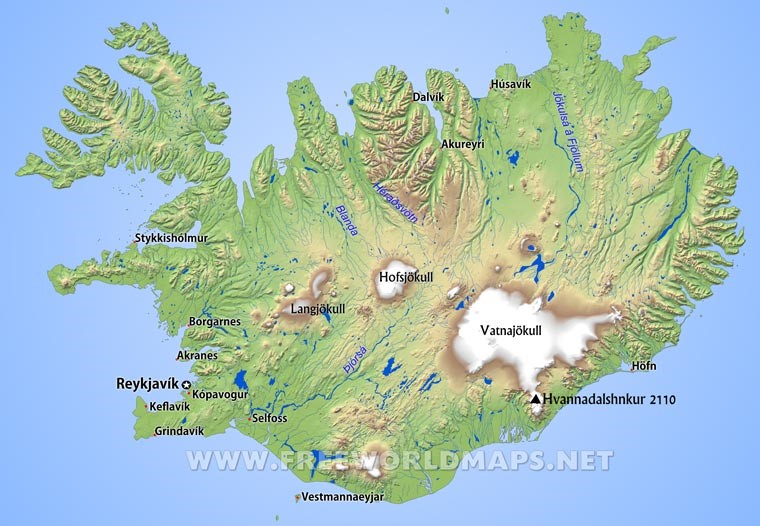
The Golden Circle Route
Cracking weather. One of those clear bright and sunny sort of days with the fairly typical Icelandic summer temperature of 15 degrees centigrade. No wind. Unusual. The sky is a deep blue with a few wispy clouds hovering about. A perfect day to drive around the Golden Circle route, taking in the stunning waterfalls of Gullfoss (Golden Falls); Geysir, an active geyser and area of hot springs; Þingvellir, the site of the old Icelandic parliament, and finishing off with a soak in the mineral rich waters of the Blue Lagoon. These places are on most travellers’ wish lists. I leave earlyish morning, not that it matters much as there are 24 hours of daylight in June. No need to worry about getting stuck out in the wilderness after dark.
Rauðhólar (Red Hills)
It doesn’t take long to drive out of the capital. Abruptly, the many newish blocks of housing come to an end and I am driving through a bleakish volcanic landscape covered with old lava flows. Also pseudo craters, which are formed when molten lava from an eruption flows over wet ground. I stop at Rauðhólar, pseudo craters by the side of the road, and have a quick scramble over them. Some of the material from here was quarried during WWII to help build Reykjavík‘s airport. Not allowed to take anything now. The hills are part of the Heiðmörk nature reserve.
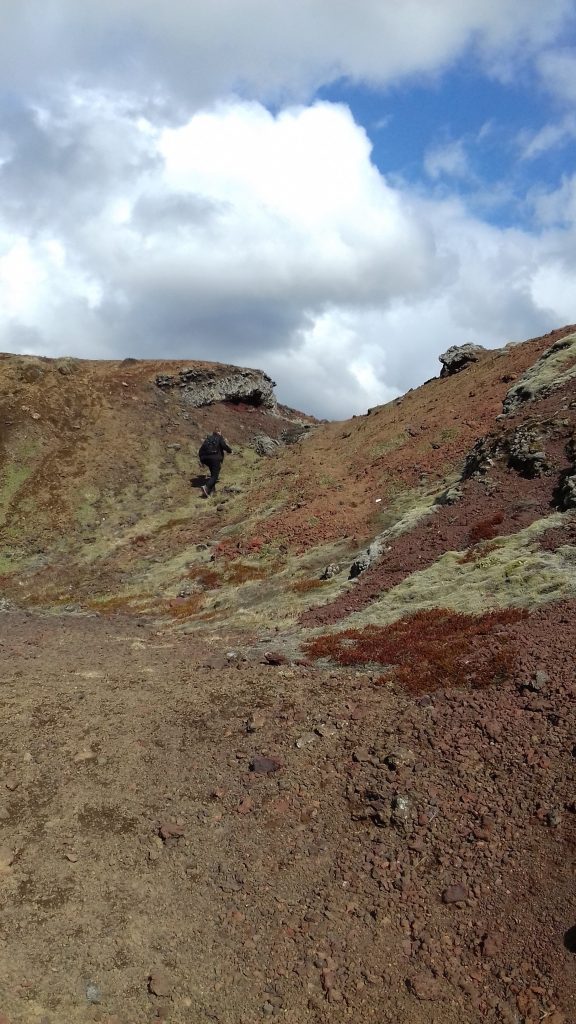
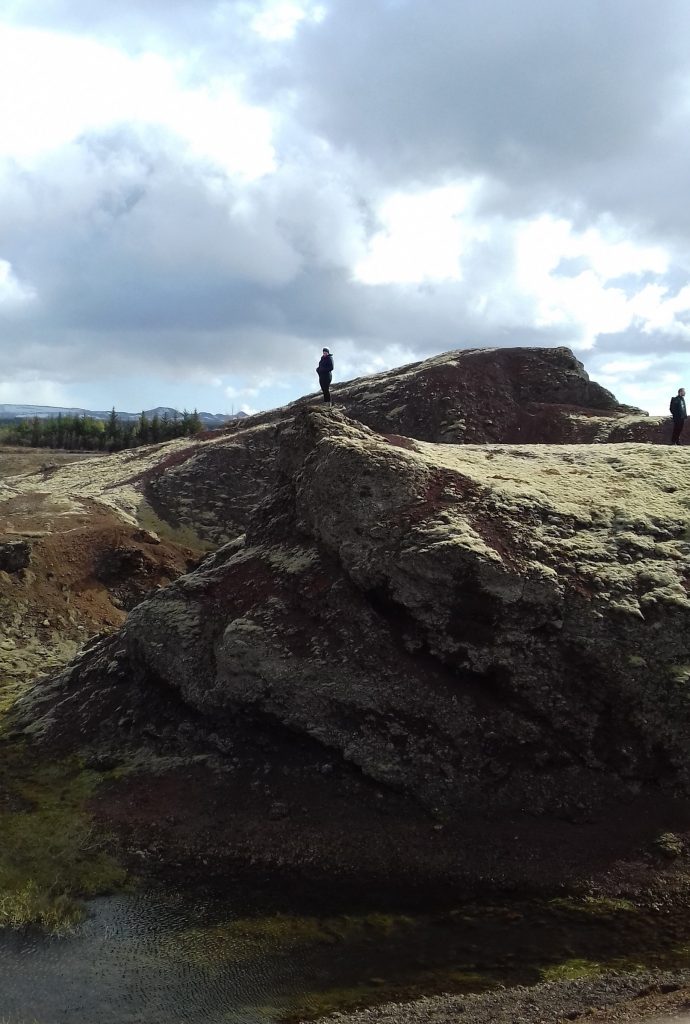
Hengill geothermal area
I resume my drive, passing the turning to the Raufarhólshellir Lava Tunnel, one of Iceland’s most popular lava tunnels. Not going there today. An unusual experience it is though, to head into the depths of a past volcanic eruption.
Ahead of me steam is pouring upwards from what is known as Hengill geothermal area, one of the most powerful geothermal areas in the world. Hence the location here of the Hellisheiði power station, which harnesses the energy and provides electricity to Reykjavík. Energy costs are much cheaper in Iceland than in the UK. Many tour groups stop at the visitor centre here. Interested geologists and rock lovers will read that Iceland is the only place in the world where the Mid Atlantic ridge, 70,000 km long, surfaces from the sea. The ridge runs right through the country from the south west to north east. This is actually the youngest part of Iceland geologically, a mere 1.6 million years old.
I continue across the high heath, where there are cairns alongside the road, once aiding horse riders and walkers, and now drivers, through winter snow storms. Once across, I stop at a handy viewpoint overlooking the coastline and the small town of Hveragerði before descending a steep winding road towards it. This is where most of Iceland’s flowers, – the town is also known as Iceland’s flower village ‒ fruit, including the unlikely banana, and vegetables are grown under glass using geothermal heat. Steam is rising from the hill. Since a major earthquake in 2008, a new area of hot springs has developed here with its bubbling water and mud.
Icelandic horses
There are several horse farms around here and I veer slightly off the beaten track to watch some horses cavorting around a field. In coats of many colours: browns, whites, greys, blacks, and combinations, long manes and long tails, they look wild and free, although they all belong to someone. Some flock to the fence as I pull up. These hardy Icelandic horses came with the first settlers from western Norway. They have two extra gaits: the tölt is a four beat gait whereby the horse lifts its legs high, useful when riding over Iceland‘s tussocks and lava. The skeið, or flying pace, is a fast two beat transverse gait. The Government, the Alþing, forbade the import of horses in 982 to prevent crossbreeding, and horses that go abroad to compete in horse shows are not allowed back in the country. Many are exported though. In fact there are more elsewhere than in Iceland itself. Today there are about 70,000 horses in Iceland, vastly outnumbered by the sheep population of about 475,000, which also exceeds the human population of the country by some margin.
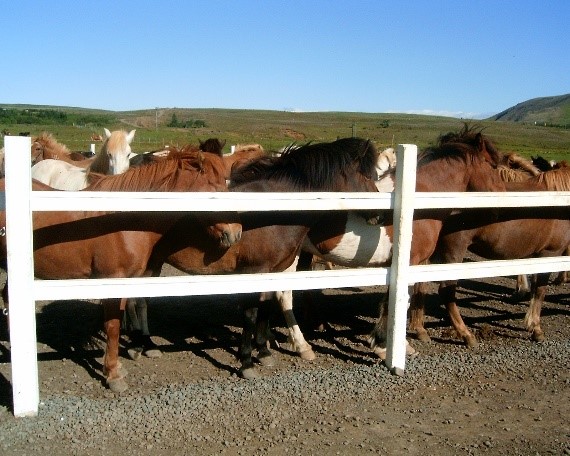
Selfoss
The ring road passes through Selfoss, situated on the banks of the Ölfusá, a prolific salmon river. The fishing season starts soon – end of June. I drive across the bridge into the town. The old bridge by the river was of great strategic importance during WWII and British troops were stationed there to guard it. There was also an airport here in Selfoss for military aircraft and a hospital. The British occupied Iceland in 1940 and built Reykjavík´s airport, before the Americans took over (see also travelogue on Iceland: A nostalgic walk around Reykjavík). Today, Selfoss is a thriving town, a commercial and administrative centre. It also houses Iceland’s biggest dairy. ‘Skyr’ is made here. Rather like a thick yoghurt but much preferable (in my opinion), skyr is rich in calcium and good for bones. Endorsed by Icelandic athletes. There are several different flavours. My favourite is blueberry, although I like the natural skyr too mixed with brown sugar and cream. Traces of skyr have been found in containers in graves from the age of settlement in the ninth and tenth centuries. It has clearly maintained its popularity.
Hekla and Eyjafjallajökull volcanos
Selfoss behind me, the flattish bleakish ring road continues. Visibility is good today and the archipelago of Vestmannaeyjar, the Westmann Islands, is visible off the south coast. Large puffin colony there. Ahead of me in the distance looms the notorious volcano, Hekla. One of the most active volcanos in Iceland, Hekla (its name means ‘hood’) has erupted around 18 times since 1104. Once known as the entrance to hell, legend has it that witches gather on the mountain over Easter. Beyond Hekla is Eyjafjallajökull, the volcano with the unpronounceable name, which erupted in 2010, causing significant disruption to air traffic. No doubt readers will recall this event as many luckless tourists were stuck abroad unable to get home by air. I was one of them. Mind you, it gave everyone the chance to seek out other greener means of transport. The eruption of Eyjafjallajökull was the best publicity Iceland could have had. It brought in millions of tourists in the years following. And, apart from during the Covid pandemic period, the number of tourists has continued rising ever since.
Geysir
I turn left towards Geysir. On the junction here below the steep cliffs are some huge boulders, which have rolled down in times past. Icelandic elves lodge around these boulders and woe betide he/she who disturbs them. Roads and developments are still planned to avoid those natural places where they reside. I don’t disturb them. Continuing some miles along the Haukadalur valley I finally spy buildings in the distance. Shops, eateries and a hotel have been built at Geysir to accommodate all the visitors flocking here. As Iceland is the only European country with active geysers, this area is an eminent attraction.
Vehicles abound in the car parks and people are making a beeline towards the hot springs. Signposts warn us all to stay on the designated pathways alongside which there are about thirty of these bubbling and hissing hot pots. Boiling pots might be a better description. Not suitable for bathing in.
Only one of them actually erupts these days, ‘Strokkur’, which means ´churn.´ Every five or ten minutes it shoots a column of water twenty metres or so into the air and tourists sometimes get burnt by the boiling water because, despite a cordon around the area, some duck under it to take selfies. Baffling. I keep an eye out but there are tour guides there cosseting their groups. There are the inevitable shrieks of delight as Strokkur spouts its stuff.
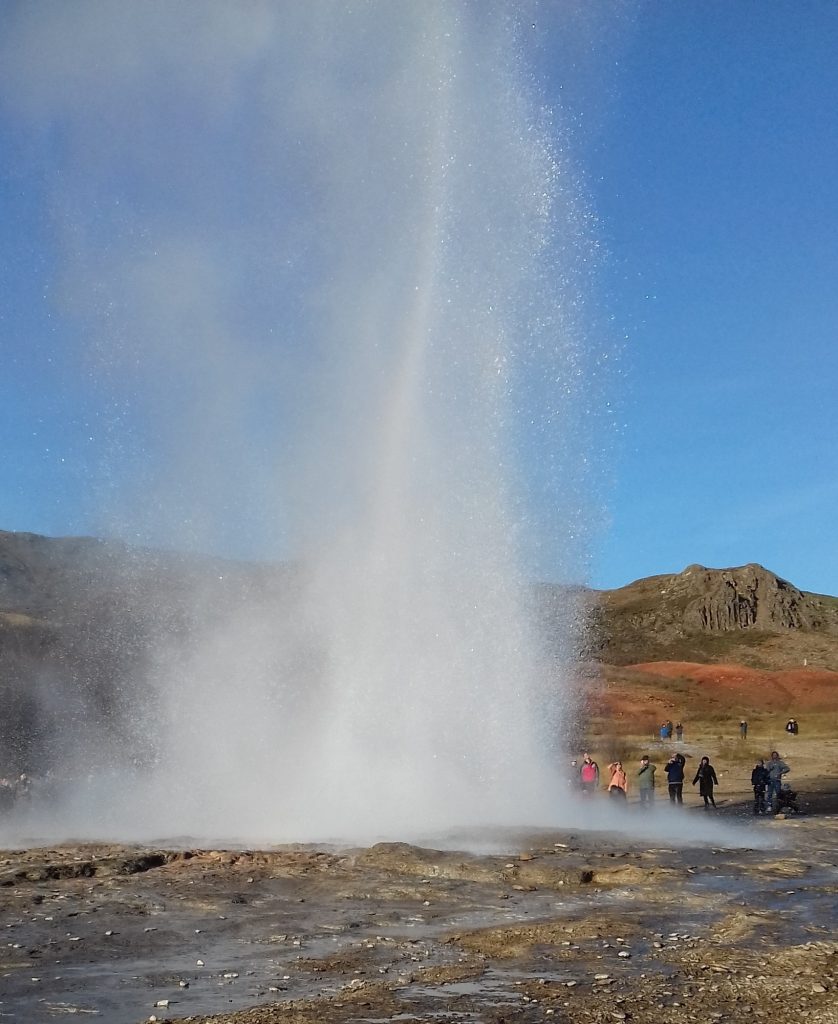
Nearby can be seen the large silica rim with the misty pool inside of the great Geysir itself, which used to erupt frequently many years ago. As the tour groups are congregating around Strokkur, nobody is here but me contemplating its mysterious depths. Geysir has only erupted twice recently, once in 2000, when a massive earthquake set it off and sent water over 100 metres into the air for two days, and a much smaller one in 2016. I was here once before the year 2000. It must have been on Iceland´s national day, June 17th, when geologists were permitted to slosh soap into it to get it going. The whole ground vibrated as this massive jet shot up over 70 metres. It carried on for a long time, as I recall. All the geysers in the world, incidentally, are named after this one.
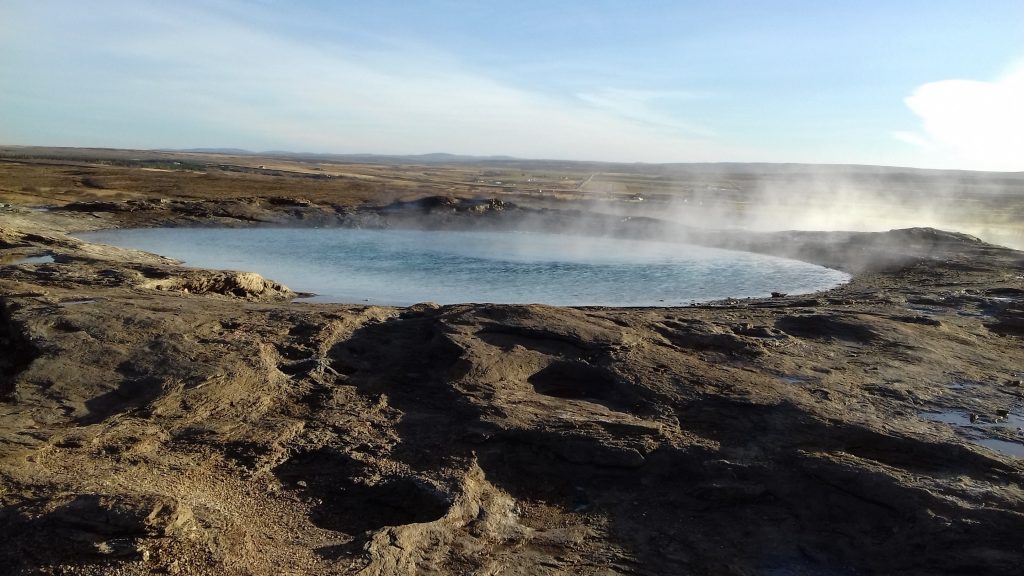
I wander back into a café and buy a coffee. I recognise one of the tour guides. Blondish beard. Built like a Viking. ‘Góðan daginn!’ Good day.
Gullfoss
Suitably refreshed, I take the road towards Gullfoss, situated in the river Hvítá (White river). The water originates in Langjökull (Long glacier), Iceland´s second biggest glacier. The icecap sparkles in the distance. Umpteen tourists are at the waterfalls. Not surprising really. They are considered the most beautiful in Iceland. I think so too. The water plummets 32 metres into a steep canyon flinging up a fine mist. Down the path I go and clamber onto a natural rocky outcrop on the edge of the falls to view them up close. There is a fence around the top of the rock but that hasn’t stopped the odd person from throwing him/herself in the river and being swept over the falls. No chance of survival. The falls are too cold and too powerful. One hundred years ago plans were made to harness them for hydro-electric power. There is a signpost where you can read about the lady campaigner, Sigriður Tómasdóttir, who protested against this plan and eventually prevented it taking place. We owe her much gratitude.
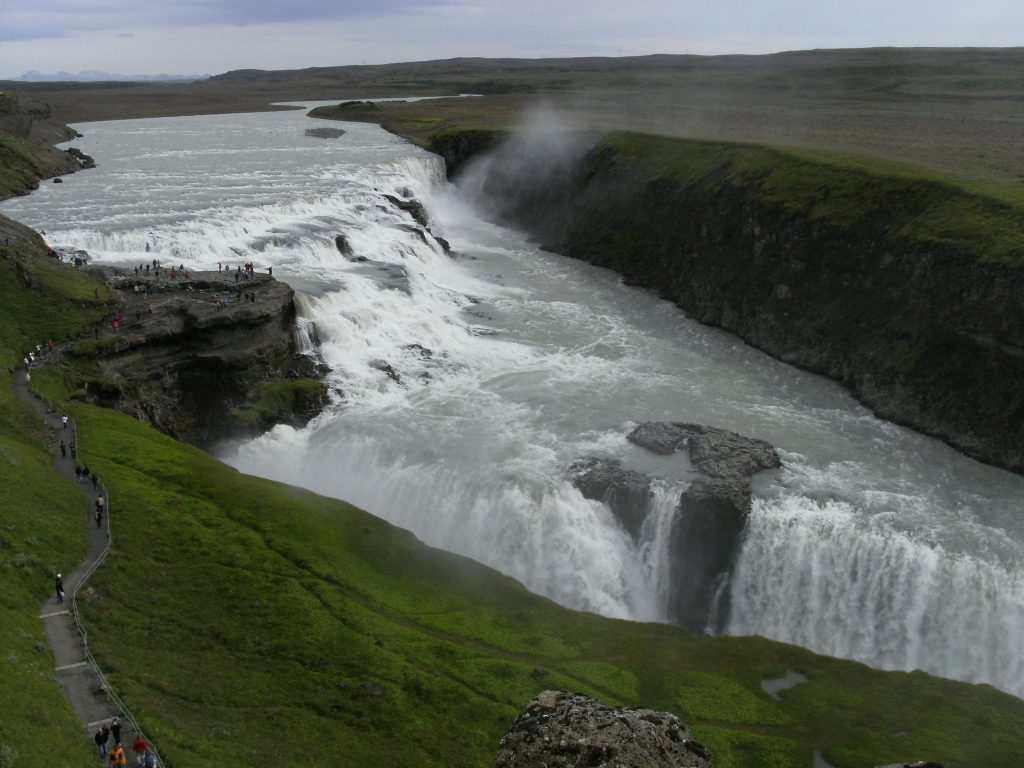
The path is wet with spray as I trample back up the slope. The occasional wild flower peeks shyly out of the grassy banks. Blushing unseen by the travellers on the track. I spot a mountain avens, also known as the arctic dryad, a small plant with white petals round a yellow centre, Iceland´s national flower. Pretty. I move above the tourist trail and find a patch of dry soft moss on a cliff on which to sit awhile and watch the thundering falls. Wild nature at its most exhilarating.
Þingvellir (Parliament Plains)
I continue my drive and, after a few more kilometres, I arrive at Þingvellir. This is where the Alþing met, for the first time in 930 and then annually until the last time in 1798 when it moved to Reykjavík. It is late afternoon and some tour groups are already heading back to their hotels. A trifle more tranquil then. I amble onto the cliff top, looking down into the rift valley below from the site of the old Lögberg (Law Rock), where the Icelandic flag is flying cheerfully. The flag has a sky blue field with a red Nordic cross, outside of which is a white cross, representing the sky, the fire and the ice respectively. The Law Speaker announced the laws from here. The law code was based on Norwegian law except that Iceland was a commonwealth, not a monarchy, and remained so until the Norwegians took over in 1262. Information boards explain that the area was a meeting point for the chieftains all over the country and that, as well as announcing new laws here, disputes were settled, criminals tried and news exchanged. Booths for attendees were erected as temporary dwellings, some remains of which can be seen lying under the tussocks. Horses would graze on the plains and there would have been plenty of trees for firewood.
Þingvellir is a stunning site and was designated a national park in 1930, one thousand years after the founding of the Alþing, and a UNESCO World Heritage Site in 2004. The view from the Law Rock takes in a little row of white painted houses, once a farm, and a little white painted church, the first church built in Iceland. Christianity was decreed here in 1000 AD by the grandson of the first settler, Þorgeir Þorkelsson, despite he himself being pagan. The pagan chieftains thus became Christian chieftains. Before this time, the Icelanders worshipped a Norse pantheon, mostly Þór (Thor) and Freyr, less frequently Óðinn (Odin/Woden). And some people carried on their pagan practices in private after 1000. Some of our days of the week are named after the Norse gods, e.g. Wednesday (Woden´s day), Thursday (Thor´s day), and Friday (Frigg’s day), while the Icelanders themselves adopted more prosaic names: mid-week day, fifth day and fasting day respectively. Rather uninspiring in comparison.
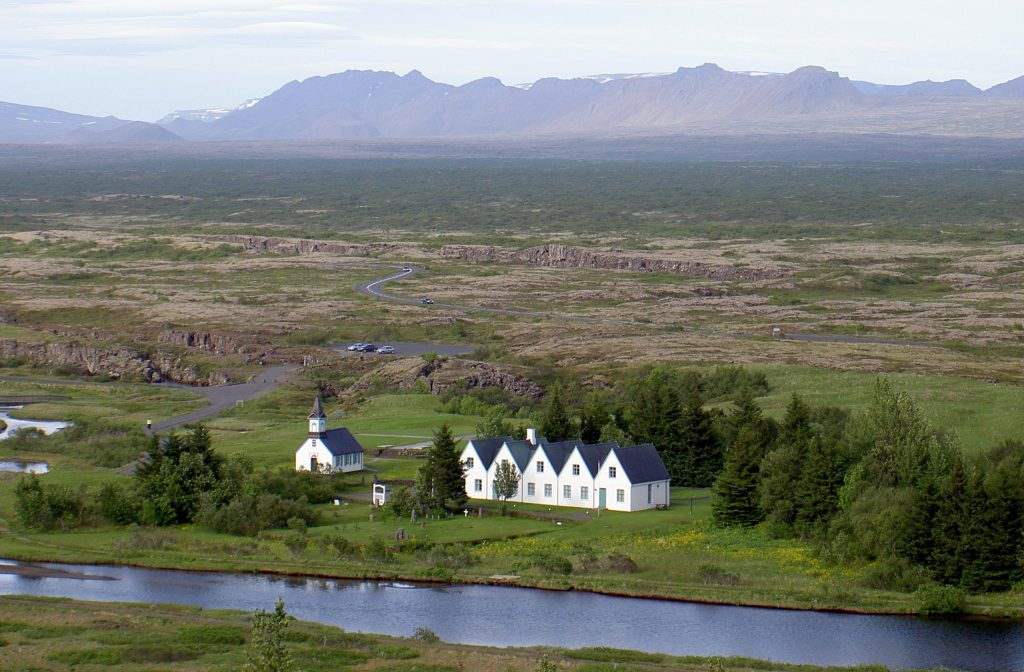
In front of the buildings flows the Öxará (Axe river) and on the bank is a little graveyard and a grassy area with yellow flowers and trees. The king of Norway, Ólaf Haraldsson, later St. Ólaf, sent a shipload of timber for the church building plus a church bell in about 1016. His half-brother, King Harald Sigurðsson or Harald Hardraade, he who would die at Stamford Bridge during his invasion of England in 1066, also sent a bell for the church. Behind the buildings the volcanic landscape is overspread with moss covered lava flows. Ravines are everywhere, some of which are filled by glacial meltwater. It is possible to dive in one, named ´Silfra.´ Two degrees centigrade. Rather you than me. Tour companies provide the necessary guides and gear. The tectonic plates meeting here are moving apart by two centimetres per year, incidentally, one centimetre in each direction, the Eurasian plate one side and the North American plate the other.
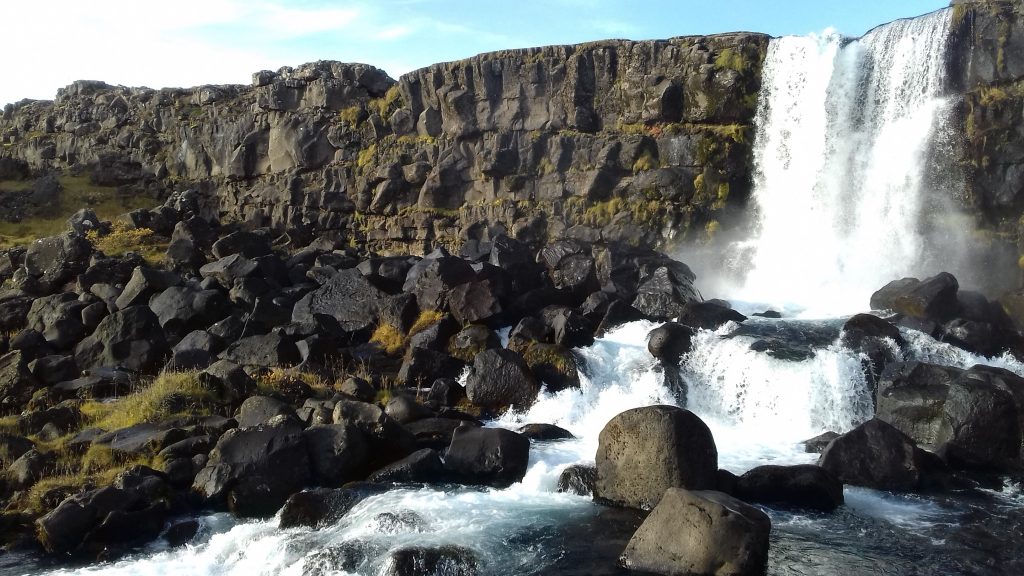
I descend slowly from the Law Rock into the spectacular Almannagjá, (Everyman gorge), portrayed as the Gates of the Moon in the Game of Thrones series, and follow the path to a man-made waterfall called Öxarárfoss (Axe waterfall), tumbling down the cliff face.
Squatting in the moss is a ptarmigan wearing its brownish summer plumage. Just minding its own business. Well camouflaged. Time to fish out my binoculars.
Peering about I also espy a golden plover. It looks like it is wearing a golden waistcoat. Handsome bird this is. Its arrival signifies the end of the harsh Icelandic winter. The largest population of plovers and whimbrels in the world breed in Iceland.
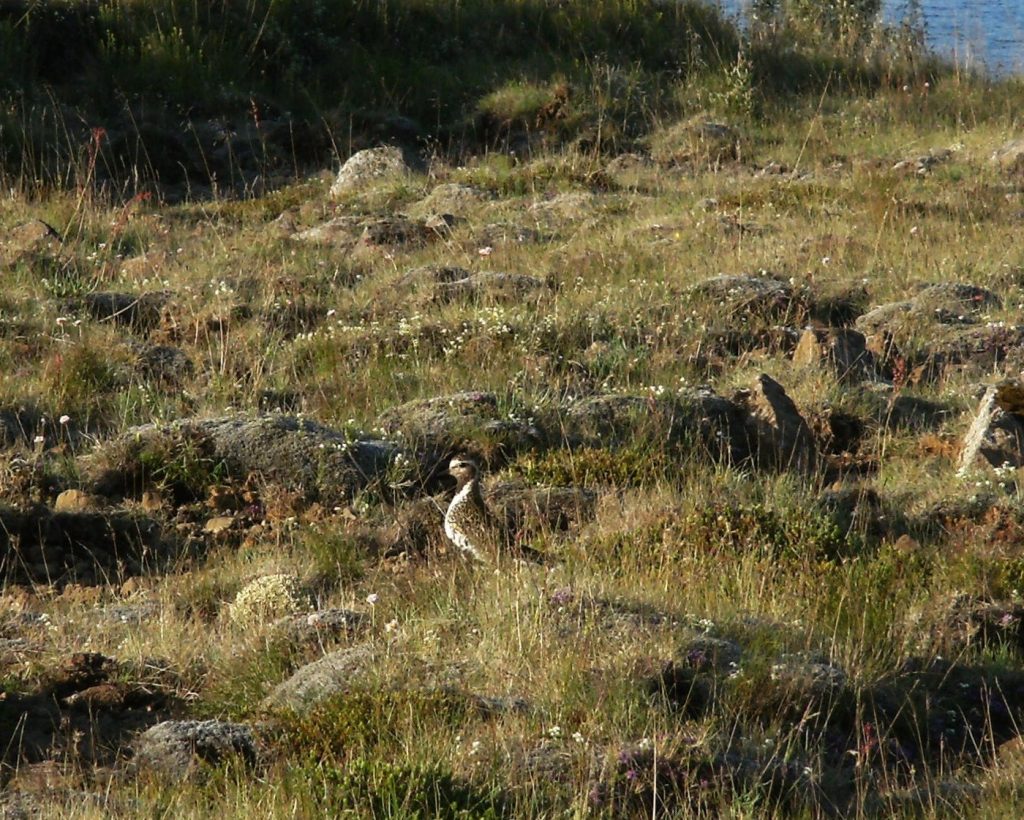
There are also three American species that breed here: the great northern diver, Barrows golden eye and harlequin duck. Bird watchers rejoice. Further along, knee-high in a pool of the river, a couple of men are fishing. They have caught a huge fish, a char perhaps and, beaming with satisfaction, are showing off the catch to the admiring public.
I wander around Þingvellir for some while communing with nature. One of those magical places.
Blue Lagoon
It is about an hour‘s drive from here to the famous Blue Lagoon located within the bleak black lava fields of the Reykjanes peninsula.
The landscape is young here, still relatively barren, as very little vegetation other than moss, the first plant that colonises after an eruption, has managed to grab a foothold.
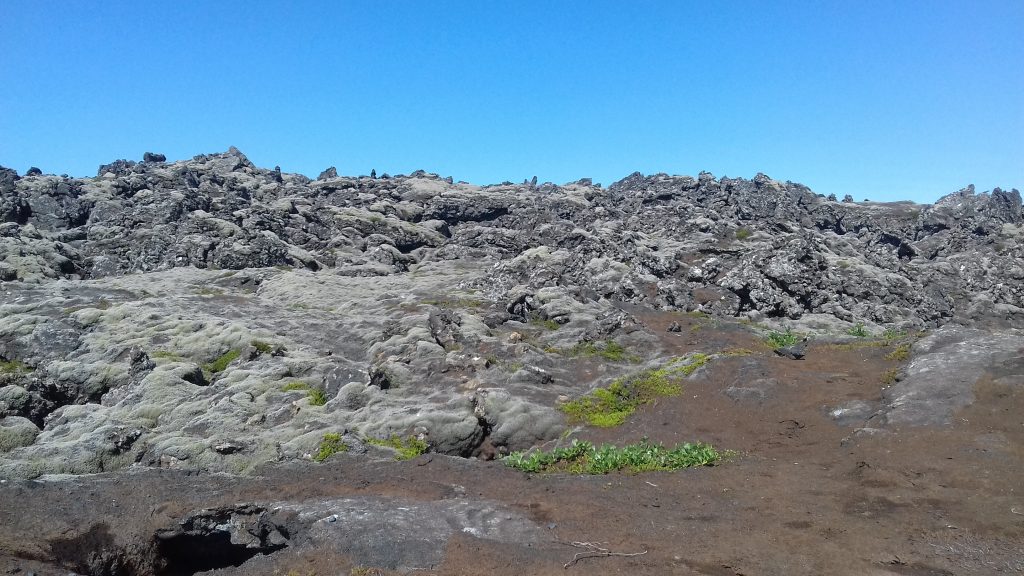
I turn off the main road along the winding track across the lava fields towards a large outpouring of steam, signifying the location of this geothermal spa.
The Blue lagoon is man made, fed by the output of the Svartsengi geothermal power plant. The water, within which are minerals, such as silica and sulphur, is reputed for helping those with skin ailments. The traveller will find all sorts of curing creams and soothing soaps to purchase within. I enter the building. There is a longish queue, even though it is early evening. Eventually, after handing over the exorbitant amount of cash – card actually as practically every establishment in Iceland prefers card over krona ‒ I am issued with a white towel and hie to the shower room.
A strict code of hygiene operates here, as with all swimming pools in Iceland, and visitors are obliged to cleanse the necessary body parts before entering the lagoon. I strip off. There are a couple of private cubicles but Icelanders don‘t use them. No inhibitions about showing off ones nakedness here, whatever your age. One or two tourists are a trifle reticent though. Thoroughly doused, I stuff my white towel into a pigeon hole. It transpiring that eveyone else is also issued with a white towel it should be easy to identify afterwards. Should have brought my own. Silly me. The water is a milky turquoise colour in which many heads are bobbing. Squishy stuff slips between my toes as I dip gently in to the enfolding warmth. Some bathers are having a drink from a bar alongside and are floating about clasping glasses. All part of the experience. Anyhow, the short Icelandic summer is always worth celebrating. Even the youngest family members are up and about until late in the evenings at this time of year.
I wallow in the warm waters for some time. A bit surreal it is, lingering here, surrounded by jagged black lava and steam. Eventually, I slither slowly out, then grab a coffee in the café before heading back to the city. A good day.
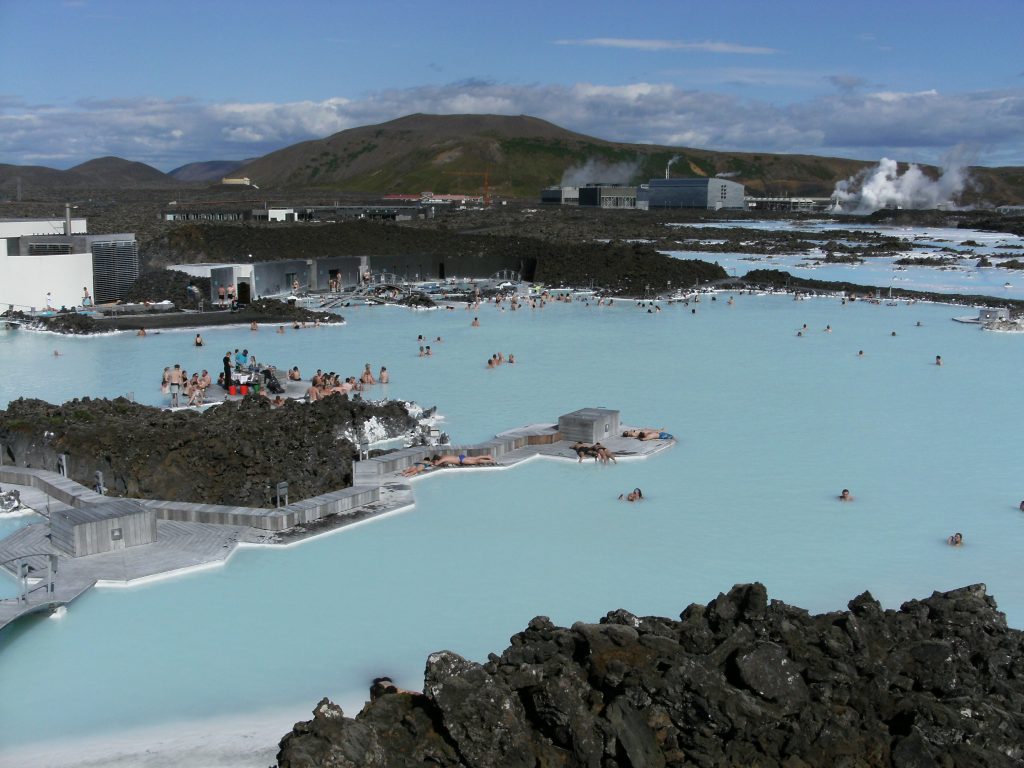
Nb. Since writing this blog, volcanic eruptions on the Reykjanes peninsula have resulted in the Blue Lagoon closing on several occasions. Interesting times.

Leave a Reply